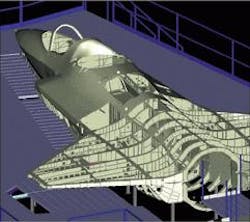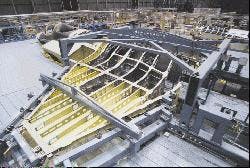Virtual prototyping is revolutionizing aircraft system design
By J.R. Wilson
St. Louis —Design anywhere, build anywhere, in less time and at lower cost. Those are key goals of aerospace engineering for aircraft, missiles, and spacecraft — and the key to reaching that goal is virtual prototyping.
"We feel this process is the most critical component of everything we`re doing," says Jerry Ennis, vice president for prototype operations and manufacturing technology at the Boeing Phantom Works in St. Louis. "The bottom line is a better economic profit ... via cycle time and asset utilization."
Virtual prototyping has a wide range of applications in the design process. Engineering analysis using virtual prototypes can predict performance values long before designers build real prototypes. Virtual prototypes also can help designers keep to a minimum the number of physical prototypes they must build or destroy to evaluate a new system effectively.
Such predictions also provide the basis for setting a system`s performance. Additionally, virtual prototyping offers an opportunity to integrate multiple disciplines into an engineering analysis — coupling models of the flight control system with the aircraft`s nonlinear aerodynamics effects and structural flexibility.
"I see virtual prototyping as the centerpiece for our whole development process in the future," agrees Gary Belie, computer integrated design manager at the competing Lockheed Martin Skunk Works in Palmdale, Calif. "In the past, when we were drawing based, it was a very handicapped technology because there was no way to regroup things on the floor. But the engineer working the hydraulic system can see what he needs; the guy on the assembly floor can see what he needs. The virtual prototyping workstations are actually on the shop floor today being used by the production people."
Two of the most common virtual prototyping programs in aerospace are CATIA and DENEB, both from France`s Dassault Systemes (and marketed in the U.S. by IBM).
CATIA is a primary design tool, while and DENEB helps designers with early tooling design, numerical control machining program prototypes, and early assembly planning. DENB can use "virtual people to check access points" and help designers determine if an average-sized maintenance technician can access an area of the aircraft during manufacturing and maintenance, notes Jim O`Neill, Boeing Military`s chief engineer for the Joint Strike Fighter (JSF) — the first manned aircraft to be fully designed using virtual prototyping.
"You build the aircraft from the manufacturing and assembly perspective before you ever cut a chip. That way, you don`t have to go out and waste part try-outs," O`Neill says. "Now we do it all virtually and our first parts are high quality that can actually go into the airplane." This approach, he says, reduces cycle time and helps move engineers on to their next effort, he says.
Boeing officials used virtual prototyping to surprise everyone in the aerospace business by unveiling both of their X-32 concept demonstrators on 14 December, even though the X-32B was started three months after work began on the X-32A model. The X-32A will demonstrate conventional takeoff and landing for the U.S. Air Force, as well as and aircraft carrier approach for the U.S. Navy. The X-32B will demonstrate short takeoff and vertical landing capability for the U.S. Marine Corps and the U.K. Royal Air Force and Royal Navy.
"We have made lean design and manufacturing a reality on the JSF program," says Frank Statkus, Boeing vice president and JSF general manager.
O`Neill says virtual prototyping has enabled Boeing engineers to build commonality into the three variants from the start, long before they cut any metal. More commonality means lower manufacturing and personnel costs during design.
"We`ve achieved a 20-to-30 percent reduction in cycle time and engineering man hours, but we`re shooting for something closer to 50. That`s a helluva goal," he says. "The other aspect is the quality of the product; just moving faster isn`t enough."
Boeing engineers have eliminated 90 percent of the changes they would typically make after defining a product, says Luis Vinuelas, the JSF process engineering manager. Virtual prototyping helps designers fit every wire bundle on the assembly floor correctly into the prescribed place the first time.
Vinuelas says virtual prototyping provides one other advantage: experience. "We are building three or four aircraft in the virtual environment, so when we build the first real aircraft, you are at aircraft five or six in terms of the learning curve. And that saves time and costs," Vinuelas says.
Lockheed Martin, which is competing with Boeing for the JSF contract to be awarded in 2001, also is using virtual prototyping-based design, which they are applying heavily to several programs, such as the Joint Air to Surface Stand-off Missile (JASSM), NASA`s X-33 single-stage-to-orbit launch vehicle demonstrator, and the follow-on VentureStar commercial reusable launch vehicle.
"On JASSM, we used it to develop all the procedures, ergonomics and tools for putting the vehicle together and making sure the tooling worked. We had a tooling person working side by side with one of our simulation people. They got the parts from the CAD system, came up with tooling concepts on how to assemble it and tried those out virtually on the computer, made necessary changes, and then developed the processes," Belie says.
"On JSF, we`re just in the process of completing a full digital mockup on the vehicle. Virtual prototyping was used on a daily basis by the designers to check on interferences and was very helpful on reviews. We did a simulation of the assembly tooling, which was the first time that had been done. They could see the impact of the structure and the tooling and were able to make it a much more friendly environment in which to work and optimize the tooling."
By placing the program into a shared virtual environment from day one, everyone involved not only is working from a common design that is maintained in real time, but such formerly disparate and often conflicting disciplines as aerodynamic design, maintenance, manufacturing, materials, and accounting come together as one team where a change by anyone is immediately seen and taken into account by all others. By making access available over an intranet, those elements need not be co-located — design anywhere, build anywhere.
On the design side, a three-dimensional solid definition also has parametric capability, which means relationships between the loft (the mathematical electronic definition of the outer mold line of the airplane) and the parts, as well as part-to-part relationships, are established within the design.
Thus if the aerodynamic engineers produce a computational fluid dynamics analysis that requires a change to reduce drag, they can quickly generate a new loft and essentially morph the entire design accordingly. This would show the necessary changes such as moving or changing the size of a rib, which in turn might influence the location of hydraulics or power systems or production or maintenance access points.
The software does all of this — including changing the shapes of affected parts and producing alerts to any potential problems — without any engineer spending weeks producing new drawings.
Central to creating a coherent integrated environment for virtual prototyping is product data management, for which Boeing uses another Dassault/IBM product called ENOVIA to manage the configuration, store the data, and provide access to several different sites around the world.
"Engineers working together in St. Louis and Seattle need to know they are looking at the same version of the design at the same time," O`Neill says. "If you didn`t have that, then you would still have the prototyping capability, but you`d also have chaos."
Component obsolescence
Virtual prototyping also helps address another problem plaguing the military — component obsolescence. Technology is advancing quickly, especially in the realm of computers and electronics. The typical five or six year design cycle of military aircraft means those components originally used in the design will be generations out of date — and out of production — by the time the first prototype is ready to fly. Boeing and Lockheed have demonstrated virtual prototyping can help bring those cycles more closely together.
"In November 1997 we first started the conceptual layout [on JSF]; in mid-December 1999 we transitioned a full-up bird to flight test ready (first flight is set for March 2000)," Ennis says of the Boeing effort. "That`s 25 months. And we did it with a fraction of the people we`ve ever deployed to a project before. Indications are we could make vast improvements now on that. On the future unmanned combat air vehicle, "we`ll go from start to flight in 19 months. We certainly think we have a good handle on a two-year program for any military aircraft to go from start to flight. A traditional fighter aircraft would have taken more than two years, Ennis explains.
While virtual prototyping has enabled everyone involved to work from individual desktop computers, Lockheed officials also have found it opens the way to new and versatile team efforts.
"We`re working on something called group virtual reality, using large, high-resolution format interactive displays with a large curved screen that can get 20 or 30 people together," Belie explains. "Static pictures on a screen just can`t show how things interact the way this does. The ability to see and comprehend complex interaction improves communication; there are no surprises, everyone is working on a common playing field."
Other innovative uses of the technology include placing virtual goggles on a maintenance engineer, who use them to enter a virtual aircraft and determine whether the current design is a help or hindrance to future maintenance. The same applies to placing a pilot into the virtual cockpit to see how well he can see and reach controls.
Technicians can use the same simulations that helped design the aircraft to train those working on the assembly floor, and afterwards to train maintenance crews.
The next step is to integrate the cost database to enable the design engineers to look at costs at the same time they look at performance. The shape, components, performance, and cost become part of an integrated "what if" analysis in virtual reality. "Most of our tools will probably be net-based in the future, which will allow us to design anywhere, build anywhere," Ennis says. "Once we create a solid model, we want to use it for everything."
Design engineers at the Lockheed Martin Skunk Works in Palmdale, Calif., are using computer-generated virtual prototypes to help them craft the future Joint Strike Fighter (JSF). Pictured above is the actual Lockheed Martin JSF X-35 being assembled at the Skunk Works, and a virtual mockup (inset) of the Lockheed Martin JSF X-35 demonstrator.


